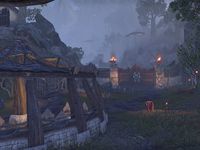Mountain Orcs were an Orcish civilization considered local by the people of the Morrowind. They were considered enemies of the native Dunmer.[1] A group known as the Malahk-Orcs was an isolated Orcish civilization known to inhabit the northern hills of Morrowind. Little is known about them, but they were described as tougher in comparison to the Orcs of the Orsinium. They were active as of Third Era and occasionally entered conflicts with the House Dunmer.[2]
According to The True Nature of Orcs, the early Orcs warred against the Nords and Chimer.[3] During the War of the First Council, during the First Era, both the Dwemer and members of the House Dagoth invited Orc and Nord clans as allies and held northwest Morrowind,[4] an area where Malahk-Orcs were known to live.[2] The second song of King Wulfharth of Skyrim talks about his various deeds to the old Nordic gods, such as his victory over the eastern Orcs and shouting their chieftains to hell.[5]
In 2E 582, the King of Orsinium, Kurog gro-Bagrakh absolved the Oathbound Clan of their crimes and leased them Malak's Maw, a mountain valley in the Valus Mountains and west of Narsis for one year.[6]
Several Daedric Ruins in Vvardenfell, such as Ashurnibibi or Zergonipal were inhabited by Orcs as of 3E 427.[7][8] Ashurnibibi also had Orc presence in 2E 582.[9][10]
GalleryEdit
NotesEdit
- Although the Orcs of the Wrothgarian Mountains are also mountain dwellers, they were officially known as the Wrothgarian Orcs.[11]
- Mauloch, also known as the Mountain Fart,[12] was associated with Velothi Mountains.[UOL 1] Mauloch troubled the heirs of King Harald for a long time. Fleeing east after his defeat at the Battle of Dragon Wall, ca. 1E 660, his rage was said to fill the sky with his sulfurous hatred, earning that year the sobriquet "Year of Winter in Summer."[12][UOL 1]
ReferencesEdit
- ^ The House of Troubles
- ^ a b Interview with a Dark Elf
- ^ The True Nature of Orcs
- ^ The Real Nerevar
- ^ Five Songs of King Wulfharth
- ^ King Kurog's Promise — Kurog gro-Orsinium
- ^ Ashurnibibi in Morrowind
- ^ Zergonipal in Morrowind
- ^ Ashurnibibi in ESO: Morrowind
- ^ Fleeing the Past quest in ESO: Morrowind
- ^ Orzorga's dialogue in ESO: Orsinium
- ^ a b Varieties of Faith: The Nords — Brother Mikhael Karkuxor of the Imperial College
Note: The following references are considered to be unofficial sources. They are included to round off this article and may not be authoritative or conclusive.
